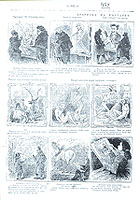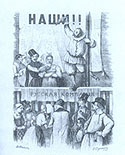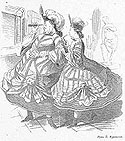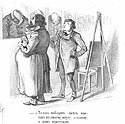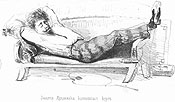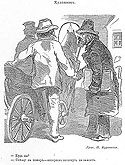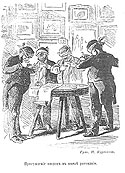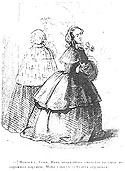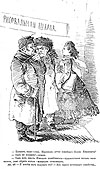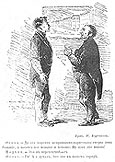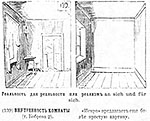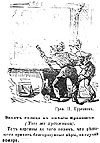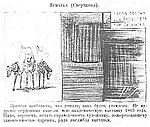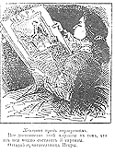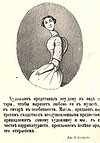The browser will either open the file, download it, or display a dialog.
|
|
The "Frisky Pencil": Aesthetic Vision in Russian Graphic Satire of the Period of the Great Reforms
|
|||||
|
Under the rule of Tsar Nicholas I (ruled 1825-1855) there was extremely limited opportunity for any form of public discussion in Russia, and still less for any satirical or critical commentary on institutions of the state. This was particularly the case during the last seven years of Nicholas' rule (1848-1855), when all forms of printed material (books, periodical publications, illustrated albums, etc.) were subject to vicious censorship by the New Committee for Censorship Affairs.1 This changed when Nicholas was succeeded by his son Alexander II in 1855 (ruled to 1881), who reformed many of the laws and institutions of what had been known as the "Dark Kingdom". While the most famous reform of this period was the Emancipation of the Serfs bill in 1861, it was only one of a raft of changes that affected military, municipal, and educational institutions. Among the educational institutions were two that dominated the art world—the St. Petersburg Academy of Arts (est. 1757), and the Moscow School of Painting, Sculpture and Architecture (est. 1843). A vastly enhanced opportunity for public discussion and circulation of information in the press arose as some censorship laws concerning the written word were relaxed, important technical innovations in printing and paper-making were introduced from Western Europe, and literacy and readership figures increased as former serf populations migrated to the urban centers.2 | |||||
| At the same time, a new form of illustration appeared in the humorous broadsheet publications that proliferated after Alexander's accession, examples of which included Yeralash (Mishmash), Vesel'chak (The Wag), Pustozvon (The Windbag), Russkoi [sic] muzhichok-govorun (The Chatterbox Russian Peasant), Spletni (Rumors), and Dyadya shut gorokhovoy so plemyannikami chepukoy i drebeden'yu (Uncle Buffoon and His Nephews Bosh and Tosh).3 The illustrations peppered throughout these publications consisted of small-scale graphic satires; they were so popular that they were even published in special appendices. Of the institutions or areas of public life these graphics addressed, one of the most significant was the art world. Two prominent weekly periodicals, Iskra (The Spark) (published between 1859 and 1873), and Budil'nik (The Alarmclock) (published between 1866 and 1917), regularly featured graphics lampooning the world of art, and, in the case of Iskra, even had a special section entitled "At the Exhibition" (or sometimes, "A Stroll Around the Exhibition") (fig. 1). | ||||||
| These graphic illustrations relating to art provide important historical evidence of the significance of the art world in urban cultural life. Their focus was on exhibitions, in particular, and they documented both paintings and audience responses in gently satirical form. In this respect they are important as a source of information about social attitudes towards art. However, I contend that they are also significant as a form of art criticism, and that one of the salient topics of their critical "discussion" is the relationship between the observer and the work of art. Starting in the late 1850s, this relationship, in all written criticism, was framed as a matter of the subject or theme of the work of art and its effect on the viewing public. This question of subject matter was a point of particular contention amongst commentators in the press who identified themselves as either "aestheticians" (i.e., supporters of the doctrine of "art for art's sake", most of whom were also supporters of the neo-classicism promoted by the St. Petersburg Academy of Arts), or "progressives" (i.e., supporters of the utilitarian doctrine of art proposed by Nikolay Chernyshevskiy in his enormously influential anti-idealist tract Esteticheskiye otnosheniya iskusstva k deyatel'nosti [Aesthetic Relations of Art to Reality], published in 1855). | ||||||
| While critics were preoccupied with arguments about thematic content (namely, whether art should reflect contemporary Russian life or not), these graphic images explored the relationship of the work of art to reality differently by positing the observer as an active participant in a process of representation. They did this in a number of ways. In some graphics, the process of representing an object on canvas was thematized and rendered the subject of discussion. Others drew attention to their own status as created images which, because of their linear nature and inherent "sketchiness", required active interpretation by the reader in order to make sense of them. Overall, these art-oriented graphics presupposed a high level of visual "literacy" in their audience. As such, they documented not only the socio-historical conditions of the art world during this period, but also attitudes in the liberal press about visual competence in the Russian viewing public. In such ways, this form of "low" art, or graphic art criticism, broadened the parameters of debate over the role of "high" visual art in society, and laid bare the conventions of all representational painting. | ||||||
| These images proliferated during a time of enormous change for the Russian art world. Between the mid-1850s and the early 1870s the hegemony of the St. Petersburg Academy was successfully challenged, an independent naturalist movement was formed—oriented towards the depiction of contemporaneous Russian society—and an economic art market developed as a moneyed middle class grew. After the isolationist years of Nicholas I's rule, which had culminated in Russia's ignominious defeat by Turkey in the Crimean War (1854-1856), all the arts, and painting in particular, were seen as vital in recovering a sense of national pride in Russia. The St. Petersburg Academy of Art had been founded in 1757, almost a century before the accession of Alexander, explicitly to foster a "national school": the Academy's centenary in 1857 provoked a great deal of critical commentary in the press on its failure to have done so.4 The negative reception given in the Russian press to the Russian Academy's submissions for the London World Exhibition of 1862 led to further dissatisfaction among critics with the work of the Academy.5 The Academy tried to counter this dissent by means of various internal reforms of syllabus and teaching methods, notably through removing the emphasis on copying from cast models by appointing a plein air teacher in 1862. Despite these changes, fourteen students from the St. Petersburg Academy established their own independent "workshop" (known as the St. Petersburg Association of Free Artists (Artel' svobodnykh khudozhnikov) in 1863, after having unsuccessfully petitioned its senior officials to allow them the freedom to choose their own subject matter for the prestigious annual Great Gold Medal competition.6 This very public revolt was seen as a rejection of the classicist doctrine taught by the Academy. In the early 1870s some also went on to join the Moscow-based Association of Itinerant Exhibitions (Tovarishchestvo peredvizhnykh vystavok proizvedenii russkikh khudozhnikov), which was considered to be the home of the Russian realist movement since it included such leading artists as Ivan Kramskoy, Isaak Levitan, Mikhail Nesterov, Ilya Repin, and Valentin Serov, among many others. These changes attracted a great deal of attention to the art world, so much so that many of Russia's most celebrated literary and intellectual figures, including Fëdor Dostoevskiy, and later in the century, Lev Tolstoy, wrote on the significance of the visual arts in Russian culture.7 | ||||||
| Written art criticism during this period, however, was constrained by several factors that made it less prominent and less effective than writings on the other arts. As a forum in which aesthetic issues in the visual arts could be discussed, art criticism had developed late; until at least the 1840s it had really only existed as reportage, recording works exhibited at the Academy but failing to engage in any particularly critical discussions. The few exceptions included Konstantin Batyushkov’s "Progulka v Akademiyu khudozhestv" (A Stroll to the Academy of Arts), published in 1814 before Nicholas became tsar, and Gogol''s "Posledniy den' Pompeya: Kartina Bryullova" (Last Day of Pompeii: A Painting by Bryullov), both of which took advantage of particularly acute periods of national anxiety to criticize the state of national art and, implicitly, the work of the Academy. While there was no such thing as a professional art critic per se until the mid 1870s, the expansion of the press after 1855 initially brought about an increase in writings on the visual arts that were not just descriptive accounts of exhibitions but also engaged with broader issues, notably, the work of the Academy. In 1863 two extremely critical articles on the Academy were published; Ivan Dmitriyev's "Rassharkivayushcheyesya iskusstvo" (The Art that Bows and Scrapes) and Vladimir Stasov's "Novye nashi blagodeteli" (Our New Benefactors").8 These in turn led the officials of the Academy (notably Fëdor Bruni, Rector of the Academy from 1855-1871) to respond in print in a series of increasingly polemical exchanges.9 Written art criticism was curtailed, however, by the re-imposition of censorship laws in the late 1860s. These laws resulted in the closure of two of the most radically-oriented journals of the time, Sovremennik (The Contemporary) and Russkoe slovo (Russian Word); in addition, the art critic Dmitriyev was arrested, as were the high profile cultural commentators Chernyshevskiy, Mikhail Mikhaylov, and Dmitriy Pisarev.10 In 1872 the censor banned all attacks on the Academy in print. | ||||||
| Written art criticism at this point, therefore, foundered for a number of reasons, including personal animosities and external political factors. Critics also began to focus upon problems inherent in the textual form, debating the merits of describing a work of visual art in words. For some, such as the liberal critic Stasov, finely honed accounts served to whet the appetite of the reader for the original work. For others, such as Vasiliy Botkin, these textual descriptions were inadequate to the task of conveying "the living entirety of impression that a picture usually exudes, like an elegant, ineffable note".11 In addition to this fundamental problem of the written form, there was also the problem of the authority of the writer. The supporters of the Academic position of "art for art's sake" believed that only the trained and tenured Academician was qualified to comment on art. These advocates of the Academy frequently wrote under noms-de-plume that stressed their "amateur" status.12 Even the democratically-inclined Stasov, who was so driven by the need to give voice to issues concerning art that he became Russia's most prolific art critic of the nineteenth century, clearly felt that the limitations of written art criticism could be overcome only by someone with extraordinary rhetorical gifts; that is, himself.13 | ||||||
| By contrast, graphic criticism of art was inherently free of such problems. The awkward distinction in textual criticism between "amateur" (i.e., Academy-trained, ideologically conservative) and "professional" (i.e., liberal, non-Academy trained) could not be applied to the graphic field, since those involved in the production of images and illustrations for the periodical press came from a wide range of backgrounds. The engravers, for instance, were often the graduates of the Academy's own engraving program, while the majority of the graphic artists were self-taught.14 Only two caricaturists working for Iskra were formally recognized artists.15 The graphic form did not therefore rely upon specialized training in the "high" visual arts. | ||||||
|
At the beginning of the 1850s the influential liberal critic Vissarion Belinskiy had commented upon this inherently "democratic" quality of images. Belinskiy had praised the handful of "polytype" albums" (polytipazhy) that had been published by artist-engravers Vasiliy Timm, Ignatiy Shchedrovskiy, and Taras Shevchenko in the 1830s and 1840s. These albums, which included Nashi, spisannye s natury russkimi (Our Folk, Drawn from Nature by Russians) (1841) (fig. 2), and Fiziologyia Peterburga (The Petersburg Physiology) (1844) were inspired by the European tradition of typological print-books or "physiognomies" which circulated widely in Russia during the late 1830s and 1840s, so that the Russian public was familiar with the work of such artists as Honoré Daumier, Paul Gavarni, and Jean-Louis Ernest Meissonier.16 Indeed, Gavarni's Les anglais peints par eux-mêmes (The English Painted by Themselves) had been published to widespread acclaim in Russia only a few months before the publication of Nashi.17 For Belinskiy, the images in these albums were:
Belinskiy argued that these images are accessible, educational, and even inspirational, not only describing contemporary life, but also serving as a conduit between elevated art and science and the masses. In this they fulfilled the explanatory function attributed to art by the liberals, who believed that the work of art should be not merely "illustrative" or descriptive, but should provide explanations, or, in the case of the physiognomy tradition, quasi-scientific typologies of reality. However, these albums were a relatively short-lived phenomenon: they appeared in any quantities only between the mid 1830s and late 1840s, and eventually disappeared altogether after the boom in the periodical press in the mid-1850s onwards.19 Despite this, they clearly influenced the works of the newspaper graphic artists of the 1850s and 1860s, as is demonstrated by case of Nikolai Stepanov, the future editor of Iskra and one of the most prolific graphic artists of the new era. Stepanov was so struck by Nashi that he produced his own album of physiological prints called Znakomye (Acquaintances) in 1856-58, before founding Iskra a year later in 1859 with Nikolai Kurochkin, a poet and graphic artist.20 |
|||||
| The influence of these album illustrations was also felt in the democratic impulse of the graphic satires of the newspaper boom. If anything, these were even more accessible than the relatively expensive, limited edition albums (known, not coincidentally, as editions de luxe), since they were widely circulated in the much cheaper format of newspaper publications. The images differed from the album images in size and quality: unlike the album image, these graphics were not carefully crafted, "finished" illustrations, but were often rough, "sketchy", and at times, small (sometimes no more than several centimeters on the page). In this sense they prioritized the transmission of information over aesthetic qualities, insofar as the graphic newspaper image was just a form of visual shorthand by which a particular message could be quickly conveyed. While they presupposed a certain degree of literacy, since they were frequently accompanied by explanatory captions, the images also served as carriers of information in their own right. Thus, they continued and even developed the quality Belinskiy had attributed to polytype images of "making everything generally and equally accessible to all and sundry, rich and poor". | ||||||
|
Both forms of illustration were also alike insofar as they sought to reveal and comment on aspects of contemporary Russian life. It could even be said that the conventions of "scientific", or at least, ordered typological representation informed some of the conventions of layout of the graphic satires, such as the convention of presenting a sequential, thematic series of images on a page. The regular feature in Iskra entitled "A Stroll Around the Exhibition" is an example of this, since it depicted many different "types" of viewers (fig. 3). An important difference, however, between the physiologies and the new graphics, lay in their attitude towards the object they depicted and attempted to "explain". According to Belinskiy's description, the album illustrations may have "explained" or "offered a vivid and vital understanding", but they were nonetheless reverential in their approach to the objects they commented on, whether a "picture by a great master" or "subjects from the natural sciences and history". In contrast, the images in the newspaper publications were satirical and irreverent, and sought to be revelatory rather than moralistic. This was such an important departure from the use of illustrations in the album tradition, that Stepanov and Kurochkin, before publishing the first issue of Iskra, distributed an explanatory statement in which they made two important points: first, they asserted that Iskra would make images as important as the text; and second, they noted that the publication would achieve its aim of "elaborating fundamental social and artistic issues as much as possible" by means of satire.21 This statement marked the beginning of a new form of vernacular illustration in Russian culture, and a new sense of the role such illustration might play in the general liberal project of enlightenment. | |||||
| The subject of satire in Iskra and Budil'nik was the organization of institutions, such as universities, publishing houses, and, of course, the Academy of Art. The offices of government or monarchy were not discussed, since Alexander's reforms did not extend to direct criticism of the imperial infrastructure. Neither was it permitted to caricature individuals, since the censors continued to be particularly alert to the potential for the graphic content of these journals to "convey suggestions of individual personages."22 This meant that these images focussed on social mores and institutions rather than individuals. | ||||||
| These graphic commentaries on social and aesthetic issues in the art world—including the problems of a system run by economic patronage, the institutional organization of the Academy, and viewing etiquette for different genders—reflected the growing dissatisfaction amongst both artists and public with the achievements of the Academy. Thus, artists were shown as driven by purely commercial interests (fig. 4), lazy (fig. 5), and lacking in a social conscience, as in the case of an artist who rushes to a fire to "have a look at the effect" (fig. 6). So too the graphics questioned the professionalism and judgement of the Academy judges, e.g. in a drawing depicting a group of blindfolded judges (fig. 7), while gender in art was also a recurring subject. For example, an image from Iskra (fig. 8) shows two young women commenting on the fact that their mother would consider the paintings they are viewing "indecent"; while in Budil'nik (fig. 9) a group of men express their surprise that a woman from a "respectable family" has become an artist.23 These graphic satires were, thus, historically significant commentary on the institutional workings of the art world as it underwent a series of profound changes. | ||||||
|
The events that caused these changes also effected an increasingly mixed social composition of the audience. Dostoevskiy gave a vivid account of this variety in his vivid, metonymic description of the crowd at the 1860-1861 Academy exhibition:
The graphics in Iskra similarly show men, women and even children from a range of clearly distinct milieus. In these graphics at least, the exhibition hall is represented as a public space in which an aesthetic experience can be shared regardless of social distinctions. The ability to read, for instance, is shown as secondary to the visual experience—indeed, reading is frequently represented as an obstacle to a genuine appreciation of the work of art. For instance, these graphics consistently mocked the authority invested in the guidebook/catalogue as provider of educational commentary, and they showed the deleterious effects of relying too much on the catalogue as a source of explanation. In one instance, a mother tells her child that a painting of a cherub is not a copy of the Italian Baroque-era artist Domenichino (as the child correctly states), but a portrait of the artist's son, because "that's what the catalogue says" (Iskra, 1859: 24). In another example, a man refuses even to look at a painting because "it's not even in the catalogue" (Budil'nik, 1867: 40). Budil'nik even published a satirical article, with graphic illustrations, entitled "Progulka s ukazatelem po khudozhestvennoy vystavke Markiza Fru Fru" (The Marquis Frou Frou's Stroll Around the Art Exhibition with Catalogue), in which much of the humor lies in Frou Frou's gleeful exposition of the catalogue's inadequacies as he goes around the exhibition (Budil'nik 1870: 11). Such images show dissatisfaction with conventional assumptions that aesthetic experience requires "authorized" explication from "experts"; instead, the exhibition space is shown as a place where audiences of all backgrounds are able to participate in a process of interpretation. In this respect, these graphics challenge expectations of interpretative authority by re-assigning it to an apparently undereducated audience. |
||||||
|
This audience, however, is represented as diverse not only in social composition, but also in visual competence. Ignorance of the fundamental principles of the visual arts (e.g., the role of the exhibition, or basic artistic terminology) is depicted across class-boundaries. In one case, for instance, a farmer is unable to view the exhibition as an event of value in itself because he assumes that the role of the artwork at the exhibition is to serve as a decorative background for other forms of entertainment. Thus he exclaims as he leaves: "So this is your exhibition?! There's no music and no buffet! The devil knows what it is!" (Iskra, 1860: 52). In other images, however, it is the socially disenfranchized observer who displays a greater visual knowledge than the privileged, upper-class viewer, as in fig. 10. Here, ignorance of a term such as "perspective" reveals the gap in knowledge between master and servant:
The aesthetic issue that emerges with particular force from these images, however, is that of mimetic representation. This was a response to the increase in exaggerated naturalist works in public exhibitions, many of which represented contemporaneous social ills. This increase was due to a number of factors, including the influence of the social-democratic movements of the mid-1850s and mid-1860s upon artists, as well as the profound influence of the European realist movement after Gustave Courbet's "Realist Manifesto". It was also a result of the increased standing of the hotly debated daguerreotype, which by this period had found a place at certain exhibitions, as both a marketing tool and as an exhibition category in its own right (cf. Iskra 1865: 44, in which photographers are shown chasing artists out of the halls of the Academy). Although the graphics in Iskra largely predate the appearance of the full-blown Russian realist movement in the mid to late 1870s (in the form of the Itinerant Association), they nevertheless demonstrate an awareness of the new European movement. Some graphics thematize the question of the subject matter of the realist painting. For instance, one entitled "Reality for reality's sake, or realism an sich und für sich" (fig. 11), depicts, in two frames, a sparsely-furnished interior with the caption "Room Interior by Mr. Bobrov 2", and in the next frame, the same interior without furniture, with the caption "The Spark presents an even more simple room." (This deliberate misapprehension of realism as Spartan naturalism refers to the works of a specific artist, Viktor Akseyevich Bobrov, who became famous for his interiors from 1862 onwards.) Others address the role of "composition", since this was considered unimportant in the new naturalist aesthetic in which images should be drawn "from life" and "unstaged": in one case a man is shown as foolishly impressed by an artwork because, as he says, "I didn't realize it was a composition: I thought it was an ordinary painting." (Iskra, 1864: 46). |
||||||
|
Most importantly, however, these graphic images engaged with the question of the techniques and conventions of representation in naturalist art. Audiences of all classes and backgrounds were shown as incapable of viewing the work of art as a form of representation, and instead as having been naively duped by the naturalist illusion to the point where they mistake the painting for the object represented. This is illustrated by fig. 12, in which fire-fighters gather before a painting, ready to take "precautionary fire measures" because of a picture's "fiery tone". In another image, a couple's discussion of a portrait takes the notion of the required "contemporaneity" of the image to an extreme:
It is important to recall at this point that these images are, of course, satirical images. They cannot, therefore, be viewed as straightforward documentary evidence that the public who went to art exhibitions during this period were incapable of distinguishing image from reality. Indeed, the viewing public had travelled some distance from its first, astonished reaction to the visual "illusionism" of Bryullov's "Posledniy den' Pompeya" as described by Gogol',25 and was increasingly exposed to illusionist, naturalist images of putatively contemporary reality through, for instance, daguerreotype images in the press. |
||||||
| These graphics depicting an extreme confusion between artwork and object of representation, then, do not necessarily represent any historical truth about the viewing public itself. Rather, they represent—and mock—the way in which the viewing public's aesthetic capacity was represented in less liberal corners of the public sphere. This is in line with Iskra's and Budil'nik's overall liberal democratic inclinations, which were opposed to the traditionalist, politically conservative, and aesthetically pro-classicist views of the supporters of the Academy. These graphics are therefore a grossly exaggerated, specular representation of the position held by those who opposed naturalism in art; they do not represent a condemnation of the viewing public itself. | ||||||
|
In fact, the visual competence of the viewing public is explored, and, I suggest, implicitly praised, on another level altogether. While these graphics may show an absence of learned aesthetic knowledge or training in the public (in the sense of technical language, for instance), they nevertheless presuppose an innate visual capacity in the public. They do so by requiring the reader to attend to the material properties of the graphic image, and to understand it as the result of a set of visual conventions applied in an active relationship between observer and image. Many emphasize their own properties as images by drawing attention towards their own provisional nature, their sketchiness, and even their incompleteness. A particularly significant example comes in "The Trade Fair" (fig. 13), in which over half of the image is occupied by dark patches. To the left, a group of horses stands with heads drooping, and in the right-hand corner there is a partly legible written statement about the exhibition guide. The caption reads as follows:
Here the focus is not only on the labor behind the scenes of the exhibition, the literal "horse-power" required, but on a work which is rendered, and represented, as incomplete as a result of this non-artistic labor. This particular image is placed at the very end, bottom right, of a series of sequential images depicting the "art exhibition". The position of the image on the page, its visual incompleteness, and the caption, all encourage the viewer to refer to the world outside the work of art in order to make sense of it. In the traditional aesthetic of "high" art supported by the Academicians, the artwork was seen as hermetically sealed from the world around it. By contrast, this graphic image and others like it, such as those which show artists hastily "finishing" their works as exhibitions are hung (e.g., Iskra, 1861: 24) not only make the extra-aesthetic context of the work of art visible, but even "praise" the labor involved. |
||||||
|
Other graphics similarly encourage readers to acknowledge their role in assigning meaning to the image or picture. A good example of this is a graphic image (fig. 14) of a "framed" picture of a woman reading Iskra, the cover of which bears an image of a female viewing a framed picture on a wall of a man seated at a desk, facing what looks suspiciously like a framed painting. The caption reads as the voice of the journal itself, as follows:
This caption offers no explanation of the image, but instead serves as an invitation to a woman reader to take part in the process of decoding the image itself. Here, the interactive process between observer and image is emphasized in the visual detective trail the caption encourages, placing the observer in a position of interpretative authority. Such graphics draw attention to their own material properties by breaking "frames" or encouraging an awareness of a context outside the image. This is even thematized in certain images in which the subjects of paintings break free of their frames: in one, entitled "Christian IV on his Horse", the Danish king leaps through the frame in order to escape the viewing audience. (Iskra, 1867: 38). In another graphic a crowd is shown fleeing from a painting in which a group of rampaging horses is depicted: the caption undoes the notion of a static relationship between observer and observed by noting that both horses and people have been "startled by the painting's unbelievable price" (Iskra, 1867: 38). |
||||||
|
One further example, taken from Stepanov's earlier publication Znakomye (1857), reveals the extent to which this irreverent approach to the conventions of "high" representational art was a conscious and long-lasting feature of the non-academically trained graphic artists who worked for Iskra. This image shows a framed painting of a woman with a strangely curved figure. It is accompanied by the following text:
Here a distinction is made between the "artist" who has discovered a technique of representation through equivalence of form, and the "caricaturist", who "bows down" before this discovery. However, the mock-reverential abasement of the "low" artist before "high" art implies quite the opposite. The caricaturist, or graphic artist, already works in a medium that relies upon a process of suggestive "equivalence"—because it is line-based, sketchy, small-scale, and ephemeral, it simply cannot exploit the illusionist conventions of the painting. The medium of the graphic artist makes him aware of the conventions of visual representation, while the "high" artist has only just arrived at a discovery of one of these conventions. |
||||||
| The graphic artists of Iskra had no elevated social status as artists or critics. Their images were not considered part of intellectual culture, and we have no way of assessing their effect on the practice of artists or of written art critics. Nevertheless, it was their own lowly position in Russian culture of this period that allowed them to exercise the quality of inquisitive, irreverent "liveliness" or "friskiness" (boykost') which was much admired in literature, but not in the "high" visual arts. These boykiye karandishisty (pencil artists), as they were called, combined the rigorous and parodic dissection of social mores with a playful, "frisky" image of prevailing aesthetic activity. In so doing they provided an exemplar—however fleeting—of new aesthetic understandings that would only be fully developed several decades later, with the rise of modernism. | ||||||
|
All translations are by the author, except where indicated. 1 . This was established in 1848, headed by D.P. Burtulin. Nicholas's efforts to control all aspects of printed publication were so extreme that the most influential journal of the period, Sovremennik (The Contemporary), described it as "an epidemic of official bookhatred". See Varshavskiy, pp. 59-64. 2. Belknap 1997, pp. 91-97, 102-114; Brooks, pp. 59-165 3. Yampol'skiy 1973, p. 15. 4. See, for instance, Maykov 1857, pp. 76-77. 5. These paintings were also exhibited at the St. Petersburg Academy in 1861. Lev Zemchuzhnikov's article "Some Notes Regarding the Latest Exhibition at the Academy of Arts" (1861) encouraged particular dissent amongst the students of the Academy. See Zhemchuzhnikov, Lev. "Neskol'ko zamechanii po povodu posledney vystavki v S.-Peterburgskoy Akademii". Osnova, 2 (1861), pp. 136-56. 6. See in particular [The Fourteen], [Petition of the fourteen students of the Academy of Arts to Prince G.G. Gagarin, Vice President of the Academy of Arts, 1863.] 7. Arbuzov 1976, pp. 6-21. 8. Dmitriyev, 1863; Stasov 1863. 9. Bruni 1861, 1865. 10. Bespalova 1977, p. 11. 11. Botkin 1855, p. 82. 12. Economic self-interest was one of the charges aimed by aestheticists at the utilitarians. The liberal critics responded by satirizing such examples of the nom-de-plume as indicator of "amateur-aesthete" status by writing under their own monikers such as "Baron Brambeus" (Osip Ivanovich Senkovskiy), "Passpartu" (passe-partout) (S.P. Diagilev), "Ne-fel'yetonist" (the non-journalist) (N.M. Ezhov), "homo novus" (A.R. Kugel'), "flanër" (the flaneur) (S.L. Kugul'skiy), "M.K. Ya-snovidets" (M.K. Clearsight) (V.M. Mikheyev), "Filosof minuty" (Philosopher of the moment) (I.I. Dmitriyev), and "Prazdnoshatayushchiysya" (The idle wanderer) (M.P. Rozengeym). This information was provided by Alexey Makhrov for the bibliographical database in Russian Visual Arts, 1800-1913, http://hri.shef.ac.uk/rva/search.htm. 13. An example of this is his scathing comment on "those who aspire to be the Russian Diderot", made with reference to Adrian Prakhov, Lecturer in Art History at the Academy of Arts, 1875-78, in Stasov 1952, p. 293. Prakhov responded in the same year with "For the First and Last time: From a Layman's Notebooks. Dedicated to the Art Critic V.S." (Prakhov 1877). Fëdor Antonovich Bruni (Rector of the Academy of Arts) was also prompted to respond to Stasov in print several times. See Bruni 1861 and 1865. 14. This field was first introduced as an academic subject in the 1810s. See Bowlt 1983, p. 224. 15. The exceptions were K.A. Trutovskiy and A.M. Volkov. Bowlt 1983, p. 227. 16. Yampol'skiy 1973, pp. 14-18. 17. Varshavskiy 1937, pp. 18-26. 18. Belinskiy 1951, pp. 329-30. 19. The other important graphic tradition before the 1850s was that of the lubki, or woodcut. This suffered three major blows over the decades of the 1850s and 1860s. First, many of the woodblocks from which the lubki were produced had been physically destroyed in 1851 by Nicholas's censors, and all subsequent lubki had to bear the imprint of the censor's approval. Second, the significant technological innovations in the 1850s to the start of the 1860s favored the broadsheet form, since mechanized steam printing presses with cheaper, lighter zinc engraving plates were introduced, as were improvements in both the quality and availability of ink and paper. Finally, the new social mobility and increased literacy of the period, particularly after 1863, meant that the previous peasant-class base of the audience for the lubki gradually began to decline or to change their affiliation instead to the hundreds of single-page pamphlets (listki) and weekly journals which were published in the urban centers of Moscow and St. Petersburg in order to satisfy the demands of the burgeoning middle class. For a detailed account of this, see Brooks 1985, pp. 59-108. 20. Stepanov and Kurochkin fell out in 1864 over a financial matter, after which Stepanov left Iskra to found Budil'nik. Yampol'skiy speculates that the authorities allowed Stepanov to establish a new satirical publication because they thought that neither publication would succeed in the absence of Stepanov and Kurochkin's creative partnership. They were wrong, but an increase in censorship intervention from 1865 to the early 1870s hampered both publications considerably. See Yampol'skiy, pp. 94-101. 21. Quoted in Sternin 1991, pp. 148-9, and in Yampol'skiy 1973, p. 76. 22. This was the reason given in 1865 by A.G. Petrov, Chair of the Censorship Commission of St Petersburg, for refusing requests from both Stepanov and Kurochkin for their images to be exempted from pre-publication censorship. In 1865 the government passed a new (and shortlived) law which freed all periodical publications from preliminary scrutiny by the censor, but this freedom did not apply to images. See Yampol'skiy 1973, pp. 98-99. There is a lengthy history of constraint on individual caricature in Russia, including a two-century ban from the early eighteenth century until 1905. The only exceptions to the ban on caricatures of individuals were those which were directed at external political enemies (such as Napoleon I during the 1810s). See Bowlt 1983, pp. 230-231; Porter and King 1983, pp. 18-19. 23. In fact, while the viewing public appeared to consist of both men and women, there were very few professional, Academy-trained Russian women artists during this time, and few foreign women artists were exhibited in Russia. The only female artist referred to by name in these graphics is Rosa Bonheur (1822-1899) (Iskra, 1861: 20, p. 350). 24. Dostoyevskiy 1978, p. 151. 25. Gogol' 1976, p. 134. |


